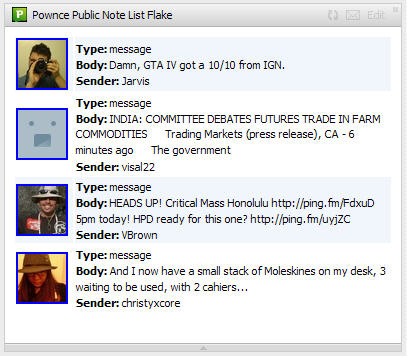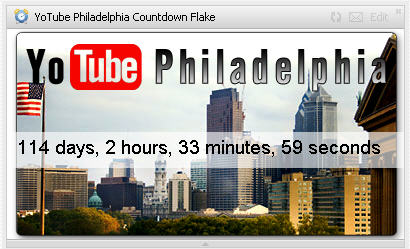I have added another page to my collection of “value added services” for YouTube users. This one is an improvement over the YouTube comment system. You can find it on my web site at: http://www.williamsportwebdeveloper.com/YouComment.aspx
The comment system is an important part of YouTube’s social networking features which also include video responses, private messages, bulletins, and channel comments. A video which receives a lot of comments will appear on the most discussed list. However, there have been many complaints about the YouTube comment system. The biggest problem is that comments can disappear because YouTube replicates their database and it does not always remain in sync. They also have not done much with the comment system.
I prefer the LiveVideo comment system because it places a small thumbnail of the user profile image next to each comment. This makes it easier to identify the participants in the conversation. YouTube currently only shows the username of the person making the comment.
Since there are so many trolls and miscreants on YouTube, it is frequently necessary to check out a user’s profile when they leave a nasty comment. This can be pretty time consuming and gives them a channel view count they may not deserve. So I used the alt text and title tag attributes to show some user profile information which appears when you mouse over the user profile image (see screen shot below). Such tool tips are an easy way to supply more information without cluttering up the screen. Unfortunately many web sites don’t take advantage of tool tips and surfers may not know to look for them.

I wanted to make this tool visually appealing so I added a speech balloon around the comments. This is another graphic design element that you can find on many other web sites. This was accomplished using Cascading Style Sheet rules to apply background images to blockquote tags.
The programming for YouComment was quite difficult. First I had to figure out how to nest comments which are replies to previous comments. The logical way to do this was to use nested unordered lists. The YouTube API returns the comment data as XML so the nested unordered lists had to match the structure of nested XML nodes. However, the YouTube API does not actually nest replies under their associated comments. There is merely an id number pointing to the previous comment. I had to re-organize the XML nodes to give them the structure that I required.
Looking up the user profile information for each comment was proving to be a time consuming operation and it was frequently redundant if the same user left multiple comments on the video. Therefore I created a hash table to store the unique user profile information and only made web requests when the user could not be found in the hash table. This has improved the web page’s performance but it still cannot handle a video with more than a hundred comments. After that you’ll find the browser acting flaky because it is using too much memory. I may need to add pagination to reduce the number of comments appearing at one time.
Most people view the comments on a video to see the replies to their comment. It can be difficult to find your comment in a page with hundreds of comments. Computer savvy users know how to use the Ctrl + F shortcut to find text on a web page. I wanted a way to highlight your comments so I added the option to store your YouTube username in a cookie. The cookie can then be used to remember your username between visits and highlight your matching comments with a yellow background.
I’m very proud of this programming exercise and I plan to use it myself. I spend a lot of time reading comments that have been left on videos. Since I’ll be using this regularly, you can be sure that I will promptly fix any bugs and make improvements if it proves to be hard to use.

 The Philadelphia Inquirer’s Walking Tour of Historic Philadelphia (Philadelphia Inquirer’s Walking Tours of Historic Philadelphia) (Philadelphia Inquirer’s Walking Tours of Historic Philadelphia): Edward Colimore: Books
The Philadelphia Inquirer’s Walking Tour of Historic Philadelphia (Philadelphia Inquirer’s Walking Tours of Historic Philadelphia) (Philadelphia Inquirer’s Walking Tours of Historic Philadelphia): Edward Colimore: Books Flash + After Effects: Chris Jackson: Books
Flash + After Effects: Chris Jackson: Books The Adobe Illustrator CS Wow! Book (WOW!): Sharon Steuer: Books
The Adobe Illustrator CS Wow! Book (WOW!): Sharon Steuer: Books





New Book On How To Become A YouTube Star
There is a new book available on YouTube. Unlike previous books, the author seems to have been heavily involved in the community and therefore knows more about the social networking aspects of the web site.
ISBN: 1592577652
ISBN-13: 9781592577651
I had this book on one of my wish lists but I did not realize that the book had finally been published until I real about it on Kevin Nalt’s blog. The book features an interview with Nalts and many other YouTube vloggers and celebrities that I am familiar with.
As you may have gathered from my previous blog entry, I am feeling very discouraged about online marketing and self-promotion. I put a lot of effort into my YouComment web application but YouTube is now including the text of the comment in their email notification so there is less need for a tool to quickly find your comments on a video. It is not just me. I see many people putting a lot of effort into online promotion without accomplishing anything because the sheer immensity of the Internet works against you.
Not that I view YouTube as a means to become famous. I don’t even appear on camera in my videos or on Stickam. Increasingly I just appreciate YouTube for its own sake. I regard the community as an extraordinary collection of weird personalities engaged in a form of dramatic improvisation. But it is not like being in a cast of characters or watching actors at their work. Rather it is like engaging in the actual world of the story. I think this is the ideal situation. For example, which would you rather do, appear on the show Seinfeld, be a member of the cast of Seinfeld, or have Kramer, Elaine, and George as your actual friends? As a fan of the show, I think you would agree that the best fantasy would be to live the story or participate in their world and share their minor adventures.
The desire for fame is a spiritual desire. It is the unconscious desire to give life a mythic quality such as dreams have. This is amply demonstrated in the ancient Greek religions in which warriors and heroes like Achilles and Hercules would become mythic figures and eventually be worshiped as gods. Fame elevates the individual into the timeless realm of mythology. Carl Jung and Joseph Campbell explored the world of the unconscious and discovered its strong yearning for a mythical life although exactly why this is so is a mystery. I am very impressed by the theory that dreams are a form of private mythology. There is a lot of evidence for this. I can remember many dreams featuring mythological monsters, strange quests into underground worlds, etc.